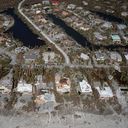How Hurricane Ian's shifting forecast caught so many off guard

Hurricane Ian was a nightmare of a storm to forecast, and experts say the tools meteorologists used to assess and communicate its likely path were part of the problem.
Why it matters: With the death toll mounting, meteorologists, emergency managers and others are asking how they could have done a better job making clear the storm would devastate the Ft. Myers area — and what lessons they can learn for the next storm.
- The story of how Ian surprised so many Floridians with its southerly shift is about far more than a computer model inferiority complex.
- It involves how we each perceive and process risk information about novel threats, as well as understand the storm graphics seen on television and online.
The big picture: Several factors combined to make Hurricane Ian the most complex domestic hurricane forecast in years.
- Computer models used to help predict the weather were at war with one another until about 36 hours before landfall, an unusually short window of time to convince coastal residents to evacuate.
- Notably, the main American forecast model, known as the Global Forecast System (GFS), insisted for days that the storm would strike the Florida Panhandle or Big Bend area as a Category 2 storm.
- At the same time, the European model, run using faster supercomputers, consistently signaled a more southerly and stronger storm track for Florida. It rarely wavered, and ended up far closer to the actual outcome.
Zoom in: In media reports, survivors of the storm in Lee County, Fla., which includes hard hit Ft. Myers Beach and Sanibel Island, have said they thought the core of the hurricane was headed for Tampa, based on previous forecasts.
- But the National Hurricane Center (NHC) split the difference between modeling guidance in its track forecasts, and consistently emphasized the uncertainty and the need to focus on more than the centerline in its "cone of uncertainty" plots.
- For example, NHC forecasters cautioned at 5am Tuesday morning: "Users are reminded to not focus on the exact track as some additional adjustments to the track are possible, and wind, storm surge, and rainfall hazards will extend far from the center."
Between the lines: Studies have shown that the 20-year-old "cone of uncertainty" graphic is often misunderstood.
- If you are in the cone, there is a two-thirds likelihood that you will see a direct hit from a landfalling storm. But it does not mean that areas outside the cone will be unscathed.
- "If you are in that, you are two-thirds likely to get the landfall. That's a pretty high likelihood of something very bad happening," said Brian McNoldy, a meteorologist at the University of Miami, in an interview.
- He said that the actual landfall location never left the cone of uncertainty in the five days prior to landfall.
What they're saying: Alberto Cairo, a journalism professor at the University of Miami who studies storm communication, recommends that journalists emphasize hurricane threats and impacts maps instead of the cone.
- "What areas may experience a storm surge? What areas may experience strong winds?" Cairo said in an interview. "Those types of graphics exist, and the National Hurricane Center is actually making an effort to push those graphics [rather than] the cone."
Reality check: Then there is the issue of how people process the forecast information they get.
- Social scientists who study the public's response to warnings say many people may have stayed in the storm's path due to "anchoring," or setting their storm expectations to the initial forecast information they received.
- Laura Myers, who studies storm risk perception at the University of Alabama, told Axios that some who did find out the growing risks and predicted impacts chose not to evacuate, since this is a complicated decision involving much more than the weather.
What's next: In a novel study, scientists are examining how people receive, process and respond to changing forecast information during hurricanes.
- This includes surveys taken during Hurricane Ian, according to study co-lead Julie Demuth of the National Center for Atmospheric Research.
- "The truth is that we know very little about people's changing risk perceptions during an evolving hurricane," Gina Eosco, a social scientist at the National Weather Service, told Axios in an email.
The bottom line: Getting the risk communication piece right will be especially crucial as climate change makes these storms more destructive.
Go deeper:
Florida still in "search and rescue phase" as Ian's death toll climbs
In photos: Florida devastated by Hurricane Ian